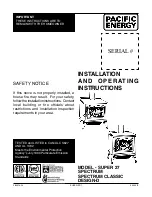
7
JINECI05 Rev. E. 11/11/2014
de-ash before refuelling and do not let the ash level
reach the underside of the grate bars.
Solid mineral fuel produces ash, which if allowed to
build-up will stifle the airflow through the Primary
air inlets and grate. This will eventually cause the
fire to die.
With some solid mineral fuels a residue of burnt
fuel or clinker will accumulate on the grate, allow
the fire to go out periodically to remove this.
IMPORTANT!
We cannot stress firmly enough how important it is
to empty the ashpan regularly. Air passing through
the fire bed cools the grate bars. Distortion or
burning out the grate bars is nearly always caused
by ash being allowed to build up to the underside
of the grate.
E
XTENDED
B
URNING
(S
OLID
M
INERAL
F
UEL
)
The stove can be banked up for extended burning.
When burning solid fuel, empty the ashpan. Open
air controls and let the fire burn brightly for a short
period. Refuel and close both air controls, the exact
setting required will depend on the fuel used and
the chimney draw so some practice may be
necessary. To revive the fire, open the air controls
until the fire is burning brightly de-ash if necessary
and refuel. Set air controls as required.
R
EDUCED
C
OMBUSTION
In order to reduce the combustion of the fire to a
minimum, close the primary air controls, then close
the secondary air slider by moving the handle all
the way to the left. If the controls are left in this
position, the fire will receive the minimum of air
and will die down. If you want to revive the fire it is
recommended that the Primary Air control is open
first and then open the secondary air slider.
REFUELING
Add the new fuel to the fire and open both air
controls fully to allow flames to establish on the
new fuel. Once the fire is established and the logs
are blackened, set the primary air control to its
closed position and adjust the secondary air to give
the desired heat output.
Never leave the stove unattended until you are
certain that the flames are fully established.
Avoid refuelling on to a low fire bed as this may
cause excessive smoke emission. Ensure there are
sufficient embers to ignite the new fuel rapidly.
Alternatively add some more kindling before
adding larger pieces of firewood. Do not add
firewood above the level of the tertiary air inlets on
the sides of the stove. Exceeding this amount can
result in the production of excessive smoke.
E
XTINGUISHING THE
F
IRE
In order to reduce the rate of combustion, close the
primary air lever and then the secondary air lever
by moving the handles all the way to the left. If the
controls are left in this position, the fire will be
starved of air and go out. If you want to revive the
fire it is recommended that the primary air control
is opened first, then open the secondary air slider.
WARNING!
The stove will remain
hot
for a considerable time
after the fire has been extinguished
R
ECOMMENDED
S
OLID
M
INERAL
F
UELS
Only authorised fuels may be used in UK smoke
control areas.
A list of authorised fuels can be found at:
http://uksmokecontrolareas.co.uk/fuels.php
This stove has been independently tested and
approved to burn manufactured and natural
smokeless fuels that appear in the HETAS guide.
A current list of approved fuels can be found at:
http://hetas.co.uk/public/hetas_guide.html
Approval does not cover the use of other fuels
either alone or mixed with the suitable fuels listed
above, nor does it cover instructions for the use of
other fuels.
WARNING!
Petroleum coke fuels or household waste must not
be burnt on this appliance. Do not use treated
timber.
Should any difficulties arise over fuel quality or
suitability, consult your local approved coal
merchant or:
HETAS Ltd.
Telephone 01684 278170 –
www.hetas.co.uk
Solid Fuel Association
Telephone 0845 601 4406 –
www.solidfuel.co.uk
W
OOD
L
OGS
Ensure your logs are well seasoned with a moisture
content of less than 20%.
Maximum
Length:
235mm (9 3/4”)
Содержание CVSECI05FM
Страница 24: ...24 JINECI05 Rev E 11 11 2014...








































